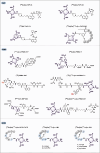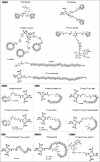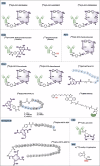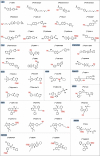Radiopharmaceuticals and their applications in medicine
- PMID: 39747850
- PMCID: PMC11697352
- DOI: 10.1038/s41392-024-02041-6
Radiopharmaceuticals and their applications in medicine
Abstract
Radiopharmaceuticals involve the local delivery of radionuclides to targeted lesions for the diagnosis and treatment of multiple diseases. Radiopharmaceutical therapy, which directly causes systematic and irreparable damage to targeted cells, has attracted increasing attention in the treatment of refractory diseases that are not sensitive to current therapies. As the Food and Drug Administration (FDA) approvals of [177Lu]Lu-DOTA-TATE, [177Lu]Lu-PSMA-617 and their complementary diagnostic agents, namely, [68Ga]Ga-DOTA-TATE and [68Ga]Ga-PSMA-11, targeted radiopharmaceutical-based theranostics (radiotheranostics) are being increasingly implemented in clinical practice in oncology, which lead to a new era of radiopharmaceuticals. The new generation of radiopharmaceuticals utilizes a targeting vector to achieve the accurate delivery of radionuclides to lesions and avoid off-target deposition, making it possible to improve the efficiency and biosafety of tumour diagnosis and therapy. Numerous studies have focused on developing novel radiopharmaceuticals targeting a broader range of disease targets, demonstrating remarkable in vivo performance. These include high tumor uptake, prolonged retention time, and favorable pharmacokinetic properties that align with clinical standards. While radiotheranostics have been widely applied in tumor diagnosis and therapy, their applications are now expanding to neurodegenerative diseases, cardiovascular diseases, and inflammation. Furthermore, radiotheranostic-empowered precision medicine is revolutionizing the cancer treatment paradigm. Diagnostic radiopharmaceuticals play a pivotal role in patient stratification and treatment planning, leading to improved therapeutic outcomes in targeted radionuclide therapy. This review offers a comprehensive overview of the evolution of radiopharmaceuticals, including both FDA-approved and clinically investigated agents, and explores the mechanisms of cell death induced by radiopharmaceuticals. It emphasizes the significance and future prospects of theranostic-based radiopharmaceuticals in advancing precision medicine.
© 2024. The Author(s).
Conflict of interest statement
Competing interests: The authors declare no competing interests.
Figures









Similar articles
-
Approaching Gallium-68 radiopharmaceuticals for tumor diagnosis: a Medicinal Chemist's perspective.Eur J Med Chem. 2025 Sep 15;294:117760. doi: 10.1016/j.ejmech.2025.117760. Epub 2025 May 14. Eur J Med Chem. 2025. PMID: 40393260 Review.
-
3p-C-NETA: A versatile and effective chelator for development of Al18F-labeled and therapeutic radiopharmaceuticals.Theranostics. 2022 Aug 8;12(13):5971-5985. doi: 10.7150/thno.75336. eCollection 2022. Theranostics. 2022. PMID: 35966589 Free PMC article.
-
Advances in Radioligand Theranostics in Oncology.Mol Diagn Ther. 2024 May;28(3):265-289. doi: 10.1007/s40291-024-00702-4. Epub 2024 Mar 31. Mol Diagn Ther. 2024. PMID: 38555542 Review.
-
A proof-of-concept study on bioorthogonal-based pretargeting and signal amplify radiotheranostic strategy.J Nanobiotechnology. 2024 Mar 10;22(1):101. doi: 10.1186/s12951-024-02312-y. J Nanobiotechnology. 2024. PMID: 38462598 Free PMC article.
-
Radiotheranostic landscape: A review of clinical and preclinical development.Eur J Nucl Med Mol Imaging. 2025 Jun;52(7):2685-2709. doi: 10.1007/s00259-025-07103-7. Epub 2025 Feb 1. Eur J Nucl Med Mol Imaging. 2025. PMID: 39891713 Review.
Cited by
-
Cooperative Role of Carbonic Anhydrase IX/XII in Driving Tumor Invasion and Metastasis: A Novel Targeted Therapeutic Strategy.Cells. 2025 May 11;14(10):693. doi: 10.3390/cells14100693. Cells. 2025. PMID: 40422196 Free PMC article. Review.
-
Facilitating PET Imaging: Eco-Friendly Purification Using Solid-Phase Material for Labeling Metal-Based Radiopharmaceuticals.JACS Au. 2025 Jun 20;5(7):3213-3218. doi: 10.1021/jacsau.5c00394. eCollection 2025 Jul 28. JACS Au. 2025. PMID: 40747069 Free PMC article.
-
Comprehensive Simulation-Based Evaluation of Gamma Radiation Shielding Performance of Bismuth Oxide- and Tungsten Oxide-Reinforced Polymer Composites for Nuclear Medicine Occupational Safety.Polymers (Basel). 2025 May 27;17(11):1491. doi: 10.3390/polym17111491. Polymers (Basel). 2025. PMID: 40508734 Free PMC article.
-
Effects of Targeted Radionuclide Therapy on Cancer Cells Beyond the Ablative Radiation Dose.Int J Mol Sci. 2025 Jul 20;26(14):6968. doi: 10.3390/ijms26146968. Int J Mol Sci. 2025. PMID: 40725216 Free PMC article. Review.
-
Transitioning from native to synthetic receptors: broadening T-cell engineering and beyond.Cell Mol Immunol. 2025 Jul;22(7):712-729. doi: 10.1038/s41423-025-01304-8. Epub 2025 Jun 6. Cell Mol Immunol. 2025. PMID: 40481182 Free PMC article. Review.
References
-
- Bollineni, V. R., Collette, S. & Liu, Y. Functional and molecular imaging in cancer drug development. Chin. Clin. Oncol.3, 17 (2014). - PubMed
-
- Aboagye, E. O., Barwick, T. D. & Haberkorn, U. Radiotheranostics in oncology: Making precision medicine possible. CA-Cancer J. Clin.73, 255–274 (2023). - PubMed
-
- Boros, E. & Packard, A. B. Radioactive transition metals for imaging and therapy. Chem. Rev.119, 870–901 (2018). - PubMed
Publication types
MeSH terms
Substances
Grants and funding
LinkOut - more resources
Full Text Sources
Medical
Research Materials
Miscellaneous

